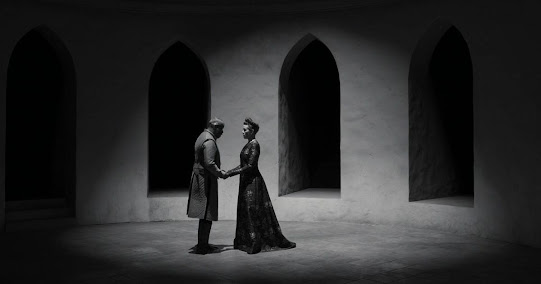I found Martin Scorsese's Killers of the Flower Moon to be the most engrossing film I've seen this year. I had read David Grann's book and was a little leery of the casting of DiCaprio and De Niro in their roles, but came away surprised and impressed by their performances. As Ernest Burkhart, DiCaprio quashes his charisma to expertly portray a dim bumpkin caught up in the venal machinations of his uncle, William "King" Hale. De Niro, who I feared would seem too urban and contemporary for the role, portrays Hale as a glad-handing, confidence man who charms the Osage while endeavoring to murder and rob them. He turns Hale into a prairie Iago.
The rest of the cast is equally exemplary. Lily Gladstone and Jesse Plemons are well cast and deliver superb performances. Even the smaller supporting roles offer intricately crafted dramatic vignettes from Barry Corbin, Ty Mitchell, Tatanka Means, Gene Jones, John Lithgow, Louis Cancelmi, Brendon Fraser, Janae Collins, and Tantoo Cardinal. I also want to note how well Scorsese utilizes musical performers in the cast, something he has done his whole career (note how he employs the Wainwright clan in The Aviator), but never as fruitfully as he does here. A performer is a performer after all, but music stars, even Elvis, often seem awkward onscreen. None seem awkward here. Jason Isbell, Jack White, Sturgill Simpson, Pete Yorn, Terry Allen, and most especially, Charlie Musselwhite offer performances as effective as the ones by more established veterans.
The music in the film is used as another layer of commentary on this narrative of woe. This is par for the course for Scorsese who is known for using pop tunes of the era on the soundtrack. To take one film as an example, in The Departed, the Rolling Stones' "Gimme Shelter is used to underline the rootlessness of his main characters. Excerpts from Gounod's Faust play up the Mephistophelian attributes of Jack Nicholson's character. Sometimes Scorsese will use a song as ironic counterpoint: a brutal murder is juxtaposed in Goodfellas with Donovan trilling his hippy-dippy "Atlantis". The Twenties tunes in ...Killer Moon are used to give the film period flavor and add a darkly ironic tone. To cite one example, the Carter Family's "Single Girl, Married Girl" is a song extolling the joy of being a free and disengaged women as opposed to one being snared by the tender trap of marriage. I have to think Scorsese was being very mindful in using this particular song in a film in which white men are shown marrying Osage women for their oil rights riches.
All through the film, Scorsese shows how American history is transmogrified into cultural artifacts: songs, photographs, newsreels, blankets, books, newspapers, and, of course, films. Ernest tries to bone up on Osage culture by reading a picture book aimed at ten year olds. This notion of the dislocation of history and the cultural artifacts that represent it is brought home by the radio play near the end of the film. That Scorsese himself delivers Mollie Burkhart's obituary in the radio displays more than a modicum of self-knowledge. He is implicating himself as an author of false narratives in American cinema, a field in which many have been all too eager to print the legend.
This mea culpa should have forestalled criticism of the film as racist, but, given our current cultural climate, it has not. Martin Scorsese has made another Martin Scorsese film outlining the dark side of our national psyche. He has not attempted to create a portrait of the Osage nation because he knows that is a story for another teller. In my brief remarks on The Irishmen, I wrote "America's facade of democratic civility is shown to mask a murderer's row" and this is equally true of ...Flower Moon. The intimations of mortality that haunt The Irishmen have morphed into a clear eyed portrait of how Americans vivisect, exhume, plunder, bury, and honor their dead. Death has become hidden away in present day America, but ...Flower Moon presents an America in which the 19th century notion of the dead as a felt and living presence still lingers. Scorsese presents the multiple corpses in the film not for the sake of gore, but as a memento mori.
The film has been labeled slow going, but I found it to be so packed with visual and auditory details as to be endlessly fascinating. A director like Christopher Nolan spoon-feeds the audience with expository dialogue in Oppenheimer whereas the information is mostly displayed onscreen in ...Flower Moon. Now I enjoyed Oppenheimer well enough, but Scorsese is in another league as a filmmaker. He has fashioned a personal epic out of an interesting, yet badly structured historical tome. Killers of the Flower Moon is another masterpiece from the greatest American director since John Ford.




.jpeg)











%20-%20joan%20bennett%20rocking%20a%20part%20down%20middle%20of%20head%202.jpg)









